Andrew and Marie Fowler farm over 30,000ha at Chilwell, Condingup, about 60 miles east of Esperance in Western Australia (WA) when ITLUS visited over a year ago - that could be much higher today.
They are pretty much at the end of the agricultural land belt and further east takes you back into the bush.
All the land in that region is relatively new, having only been reclaimed from bushland in the late 1960s and early 1970s.
Andrew’s father was given access to the land following his army service.

Eight combines harvest over 20,000ha of crops.
The initial farm was 3,500 acres, but at that stage the location was very remote.
He started farming by rearing sheep and his first year turned out quite well.
Land reclamation involved hauling big chains across the surface to uproot existing vegetation and dragging it into piles for burning.
After that, the land was ploughed and root rakes were used to form windrows of roots, etc, to complete the cleaning up process.
The final action was to sow the land with ryegrass and clover.
A good place to farm
Andrew described the area as a good place to farm. The ocean can be seen from many parts of the farm and rainfall amounts are fairly reliable, with very little frost risk.
Rainfall in this area is about 500mm per annum, with 350mm during the growing season. He said that rainfall is up to 100mm higher close to the coast and decreases substantially as you move inland.
The business has grown a lot since the early days. His father increased the farm size by about 10,000 acres following good years in wool.
In the early days, the farm was about two-thirds wool or sheep and one-third crops - now the whole region is 90% cropped.
The official system to control the supply of wool ended up with big stocks and ultimately crashed the market.
While it is mainly a crop farm, Andrew described livestock as risk management. So, the farm also carries about 25,000 ewes and 2,500 Aberdeen Angus-cross suckler animals.
Security is not an issue on the farm. There is no theft, no issue with keys, no locking up - the farm is too far from anywhere.
The furthest land is located about 35km away from the farmyard, but that is a 5,000ha block, so it is a worthwhile journey.
Andrew commented that land could generate its cost in turnover in three to five years, depending on the seasons. He grows some GM oilseed rape, but noted that the price is lower.
The cropping operation
Until 1996, the biggest crop grown was barley. From that point onwards, the use of no-till establishment was a big help to his farming system.

A yard full of combine headers -- eight combines with 12 headers (mainly 12m width) mop up the harvest.
When ITLUS visited the family in January 2020 he had recently finished a 72,000t harvest, which yielded just under 5t/ha on average across the farm area.
This was a massive yield for him and more than 1t/ha higher than his previous best.
One of the first things you notice as you drive into Chatham farm is the three large grain bins and an Alvan Blanch grain drier.
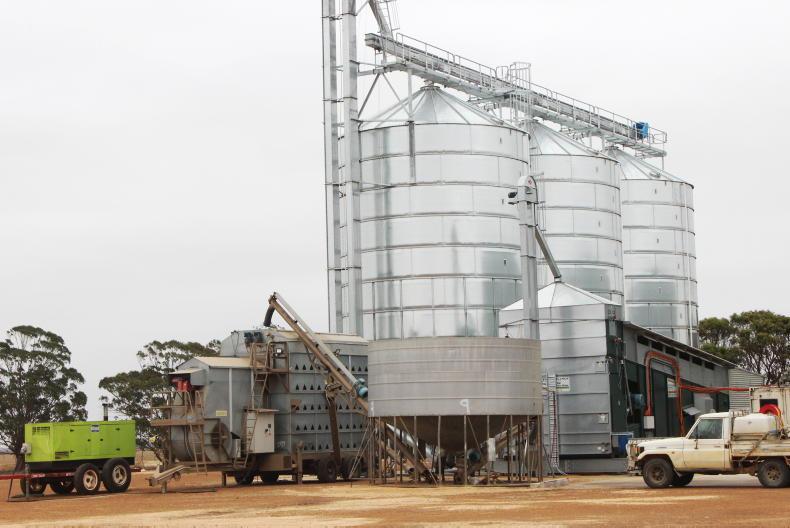
The new grain drying and handling unit.
In Australia grain must be less than 13% moisture for delivery to any of the elevators and, in 2019, moistures off the combine were considerably higher than that.
Having operated a batch dryer around the clock for many weeks, Andrew decided to invest in the drying system, which cost him about AUS$1m.
One year later, it had not been used because the grain came in dry off the combine.
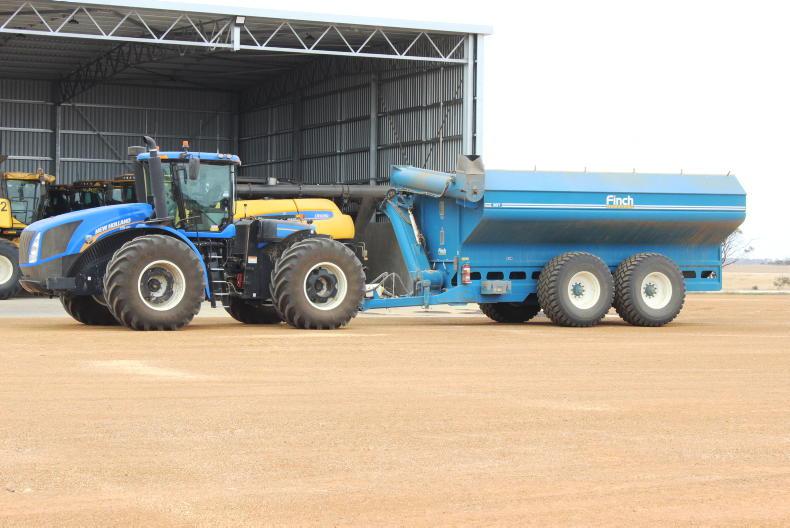
The equipment is big to match the area and these 38t chaser bins are being replaced by 55t units on tracks.
He also stores some grain in 330t sausage bags out on the land, which cost about $1,000 each. They hold about 330t. There is some spoilage from these, as mice puncture the bags.
While remoteness is good for security, it becomes an issue for things such as access to machinery dealers and spare parts.
Because of this, the farm must carry all major machine parts they think they are likely to need. They must also have the capability to do their own repairs, which means fully kitted workshops.
Fire danger index
At harvest time, Andrew operates eight large New Holland combines, some on tracks, equipped with 12 headers, most of which are 12m.
These work in two gangs, each serviced by several 38t chaser bins. These are now being replaced by 55t units running on tracks.

One of the new 55t chaser bins running on tracks on the Fowler farm.
Combines normally travel at 12km/h to 14km/h in the lighter crops, but that year (2019 harvest) the forward speed was down to 7km/h or 8km/h because the crops were so much better.
Straw is cut low at harvest so that it does not clog the drills. He makes about 5,000 round bales for the stock and the rest is normally chopped.
The rape is desiccated for harvest and the wheat is occasionally desiccated too. During harvest, local government can implement a ban on machinery operation and movement to protect against fire risk.
The temporary ban on movement is activated by the fire danger index (FDI), which is largely a consideration of temperature and windspeed.
Any temptation to break the ban will make one’s insurance null and void, so the risk is high if you start a fire.
This risk means that Andrew always has at least 1,000 litres of water on hand, just in case. As a further risk mitigation, combines are blown down every morning before they begin.
Labour
The farm is operated by five key people and they can trawl Australia to get them.
At peak workload, the farm will have about 50 staff – most will be casual. Labour casual is generally got by word of mouth, as he provides good facilities and accommodation.
He operates a code of conduct for workers as part of a duty of care.
He will occasionally sponsor immigrants to come and work for him, a process that costs approximately AUS$15,000 for the permanent visa for English-speaking applicants.
There is some competition locally for labour and land, but this has helped the local area to develop and thrive. Farmers share knowledge, as there are no third-generation farmers in the region.
Manage for productivity
The farm business is managing the land to help its productivity. The livestock are an essential part of this.
They utilise self-regeneration low-input pastures that fixes nitrogen.
They grazed much of their cereals, and rape in particular. This enables relatively high stocking rates by local standards.
Profitability is essential to grow the business and Andrew's ambition is to continue to buy more land. While most land is purchased, he has some long-term land leases.
The leasing arrangements used help to provide profit for the purchase of new land.
Leasing is done by fixing a rate and then adjusting on the run, if necessary.
Land price is approximately related to the quality of the land and Andrew said he can generate about 10% to 15% return on capital. And when leases expire, it is often the case that the user gets the opportunity to buy it.
The one-third pastureland is renewed every three years and goes from pasture to crop. Reseeds involve perennial ryegrass, clover and vetch.
Uniquely, the clover seeds grow naturally from the soil when they get a chance, so they are not a cost in the reseeding process. This cycling of grazed grass is critical to the performance of the farm.
Andrew commented that increased nutrition is giving increased yield - this means more nitrogen and some potash. He also said that he is now using three fungicides on some of his crops.
On the crop land, all grass weeds are controlled in the stubbles with gramoxone at the end of the season.
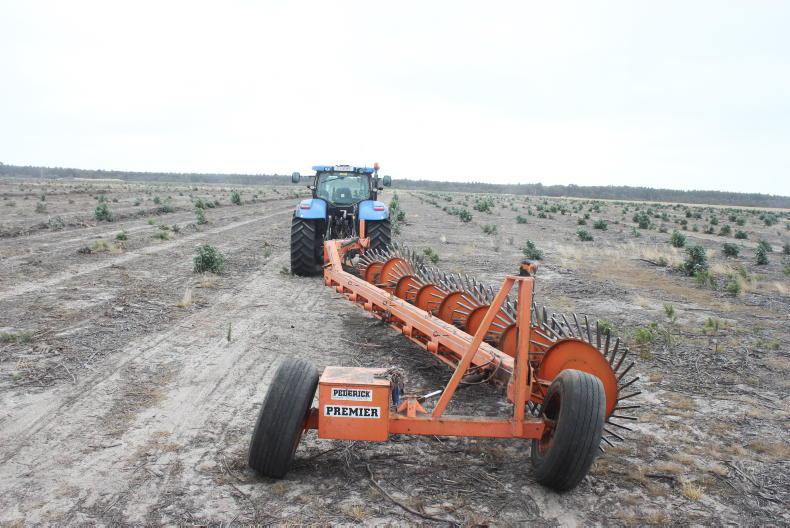
The windrower used to tidy up tree stumps when reclaiming land.
It is still legal in Australia because it was argued that if the farming community did not have it to protect glyphosate, they could quickly end up with no ability to control resistant grass weeds such as ryegrass, which is a huge issue across much of WA.
The grass weed issue has given rise to various systems to try to control seeds return.
Most farms exercise some control on the placement of chaff, such as dumping, placement in wheel tracks, milling them on the combine or using fire – the latter is a huge risk in a climate that can be very dry.
Taxes
There is no inheritance tax on generational transfer, but there is some capital grains tax where the land is sold.
He emphasised that the farmer only owns the top few inches of the soil and has no entitlement to the minerals that may lie beneath.
The farm business is run as a company and, with a number of different operations, it needs a good accounting system.
The tax rate applicable to the company is 30% and Andrew indicated that this may decrease to 25% in the future. Personal tax rates top off at 45%.
Lime pit
One major asset on the farm is the presence of a lime pit. This provides essential lime for the farm, plus additional sales.
The pit is shallow and so not going down to where minerals might be, but permission still involved a lot of paperwork. It also involved some payment to the local authority to upgrade local roads, etc.
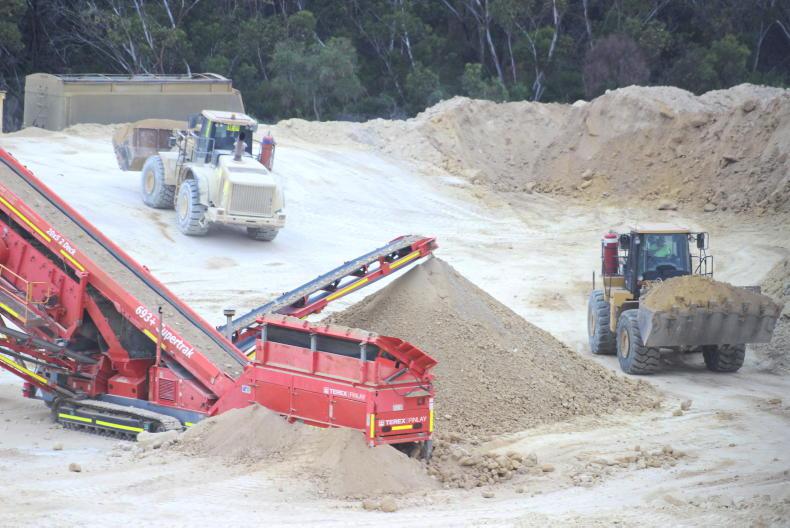
The lime pit on the farm uses a soft rock that requires very little grinding to make an active product.
Andrew described the lime as being “soft” and quite soluble, so there is no need for fine grinding. This is a simple operation with basic screening and loads are weighed during loading using a scales on the loader bucket.
A standard load tends to be about 50t in two trailers.
Bringing back forestry land
Part of Andrew’s land base involves land that he is taking back from forestry.
In recent years, there was a Blue-gum plantation scheme to encourage the production of this eucalyptus species for woodchip production.
The level of production has collapsed the market and now many of those plantations are coming back into agricultural production once the trees have been harvested.
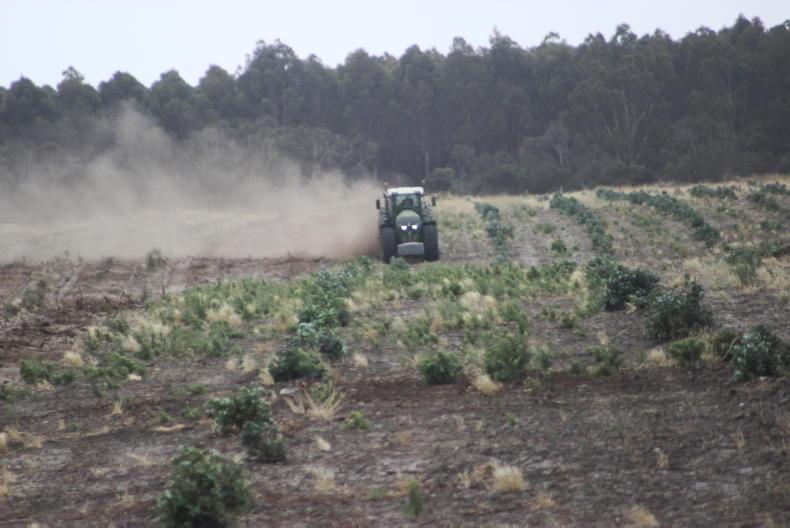
Grinding up the stumps of the bluegum plantation to get the land back into cropping.
When we visited, Andrew was still in the process of reclaiming some of this land. The process was demanding on both labour and diesel, with the cost of grinding the stumps put at AUS$500/ha working on a 24-hour basis.
An Irish connection
We received a very warm welcome during this visit as Andrew’s wife, Marie, hails from Armoy in Co Antrim.

Andrew and Sean Fowler in the farm workshop.
They met when she worked for the Ulster Farmers Union in Brussels and the rest is history.
They have two children, Sean and Bróna, and they are totally immersed in the farm business. GAA jerseys and the cúpla focal were evident about the house.
Andrew and Marie Fowler farm over 30,000ha at Chilwell, Condingup, about 60 miles east of Esperance in Western Australia (WA) when ITLUS visited over a year ago - that could be much higher today.
They are pretty much at the end of the agricultural land belt and further east takes you back into the bush.
All the land in that region is relatively new, having only been reclaimed from bushland in the late 1960s and early 1970s.
Andrew’s father was given access to the land following his army service.

Eight combines harvest over 20,000ha of crops.
The initial farm was 3,500 acres, but at that stage the location was very remote.
He started farming by rearing sheep and his first year turned out quite well.
Land reclamation involved hauling big chains across the surface to uproot existing vegetation and dragging it into piles for burning.
After that, the land was ploughed and root rakes were used to form windrows of roots, etc, to complete the cleaning up process.
The final action was to sow the land with ryegrass and clover.
A good place to farm
Andrew described the area as a good place to farm. The ocean can be seen from many parts of the farm and rainfall amounts are fairly reliable, with very little frost risk.
Rainfall in this area is about 500mm per annum, with 350mm during the growing season. He said that rainfall is up to 100mm higher close to the coast and decreases substantially as you move inland.
The business has grown a lot since the early days. His father increased the farm size by about 10,000 acres following good years in wool.
In the early days, the farm was about two-thirds wool or sheep and one-third crops - now the whole region is 90% cropped.
The official system to control the supply of wool ended up with big stocks and ultimately crashed the market.
While it is mainly a crop farm, Andrew described livestock as risk management. So, the farm also carries about 25,000 ewes and 2,500 Aberdeen Angus-cross suckler animals.
Security is not an issue on the farm. There is no theft, no issue with keys, no locking up - the farm is too far from anywhere.
The furthest land is located about 35km away from the farmyard, but that is a 5,000ha block, so it is a worthwhile journey.
Andrew commented that land could generate its cost in turnover in three to five years, depending on the seasons. He grows some GM oilseed rape, but noted that the price is lower.
The cropping operation
Until 1996, the biggest crop grown was barley. From that point onwards, the use of no-till establishment was a big help to his farming system.

A yard full of combine headers -- eight combines with 12 headers (mainly 12m width) mop up the harvest.
When ITLUS visited the family in January 2020 he had recently finished a 72,000t harvest, which yielded just under 5t/ha on average across the farm area.
This was a massive yield for him and more than 1t/ha higher than his previous best.
One of the first things you notice as you drive into Chatham farm is the three large grain bins and an Alvan Blanch grain drier.

The new grain drying and handling unit.
In Australia grain must be less than 13% moisture for delivery to any of the elevators and, in 2019, moistures off the combine were considerably higher than that.
Having operated a batch dryer around the clock for many weeks, Andrew decided to invest in the drying system, which cost him about AUS$1m.
One year later, it had not been used because the grain came in dry off the combine.

The equipment is big to match the area and these 38t chaser bins are being replaced by 55t units on tracks.
He also stores some grain in 330t sausage bags out on the land, which cost about $1,000 each. They hold about 330t. There is some spoilage from these, as mice puncture the bags.
While remoteness is good for security, it becomes an issue for things such as access to machinery dealers and spare parts.
Because of this, the farm must carry all major machine parts they think they are likely to need. They must also have the capability to do their own repairs, which means fully kitted workshops.
Fire danger index
At harvest time, Andrew operates eight large New Holland combines, some on tracks, equipped with 12 headers, most of which are 12m.
These work in two gangs, each serviced by several 38t chaser bins. These are now being replaced by 55t units running on tracks.

One of the new 55t chaser bins running on tracks on the Fowler farm.
Combines normally travel at 12km/h to 14km/h in the lighter crops, but that year (2019 harvest) the forward speed was down to 7km/h or 8km/h because the crops were so much better.
Straw is cut low at harvest so that it does not clog the drills. He makes about 5,000 round bales for the stock and the rest is normally chopped.
The rape is desiccated for harvest and the wheat is occasionally desiccated too. During harvest, local government can implement a ban on machinery operation and movement to protect against fire risk.
The temporary ban on movement is activated by the fire danger index (FDI), which is largely a consideration of temperature and windspeed.
Any temptation to break the ban will make one’s insurance null and void, so the risk is high if you start a fire.
This risk means that Andrew always has at least 1,000 litres of water on hand, just in case. As a further risk mitigation, combines are blown down every morning before they begin.
Labour
The farm is operated by five key people and they can trawl Australia to get them.
At peak workload, the farm will have about 50 staff – most will be casual. Labour casual is generally got by word of mouth, as he provides good facilities and accommodation.
He operates a code of conduct for workers as part of a duty of care.
He will occasionally sponsor immigrants to come and work for him, a process that costs approximately AUS$15,000 for the permanent visa for English-speaking applicants.
There is some competition locally for labour and land, but this has helped the local area to develop and thrive. Farmers share knowledge, as there are no third-generation farmers in the region.
Manage for productivity
The farm business is managing the land to help its productivity. The livestock are an essential part of this.
They utilise self-regeneration low-input pastures that fixes nitrogen.
They grazed much of their cereals, and rape in particular. This enables relatively high stocking rates by local standards.
Profitability is essential to grow the business and Andrew's ambition is to continue to buy more land. While most land is purchased, he has some long-term land leases.
The leasing arrangements used help to provide profit for the purchase of new land.
Leasing is done by fixing a rate and then adjusting on the run, if necessary.
Land price is approximately related to the quality of the land and Andrew said he can generate about 10% to 15% return on capital. And when leases expire, it is often the case that the user gets the opportunity to buy it.
The one-third pastureland is renewed every three years and goes from pasture to crop. Reseeds involve perennial ryegrass, clover and vetch.
Uniquely, the clover seeds grow naturally from the soil when they get a chance, so they are not a cost in the reseeding process. This cycling of grazed grass is critical to the performance of the farm.
Andrew commented that increased nutrition is giving increased yield - this means more nitrogen and some potash. He also said that he is now using three fungicides on some of his crops.
On the crop land, all grass weeds are controlled in the stubbles with gramoxone at the end of the season.

The windrower used to tidy up tree stumps when reclaiming land.
It is still legal in Australia because it was argued that if the farming community did not have it to protect glyphosate, they could quickly end up with no ability to control resistant grass weeds such as ryegrass, which is a huge issue across much of WA.
The grass weed issue has given rise to various systems to try to control seeds return.
Most farms exercise some control on the placement of chaff, such as dumping, placement in wheel tracks, milling them on the combine or using fire – the latter is a huge risk in a climate that can be very dry.
Taxes
There is no inheritance tax on generational transfer, but there is some capital grains tax where the land is sold.
He emphasised that the farmer only owns the top few inches of the soil and has no entitlement to the minerals that may lie beneath.
The farm business is run as a company and, with a number of different operations, it needs a good accounting system.
The tax rate applicable to the company is 30% and Andrew indicated that this may decrease to 25% in the future. Personal tax rates top off at 45%.
Lime pit
One major asset on the farm is the presence of a lime pit. This provides essential lime for the farm, plus additional sales.
The pit is shallow and so not going down to where minerals might be, but permission still involved a lot of paperwork. It also involved some payment to the local authority to upgrade local roads, etc.

The lime pit on the farm uses a soft rock that requires very little grinding to make an active product.
Andrew described the lime as being “soft” and quite soluble, so there is no need for fine grinding. This is a simple operation with basic screening and loads are weighed during loading using a scales on the loader bucket.
A standard load tends to be about 50t in two trailers.
Bringing back forestry land
Part of Andrew’s land base involves land that he is taking back from forestry.
In recent years, there was a Blue-gum plantation scheme to encourage the production of this eucalyptus species for woodchip production.
The level of production has collapsed the market and now many of those plantations are coming back into agricultural production once the trees have been harvested.

Grinding up the stumps of the bluegum plantation to get the land back into cropping.
When we visited, Andrew was still in the process of reclaiming some of this land. The process was demanding on both labour and diesel, with the cost of grinding the stumps put at AUS$500/ha working on a 24-hour basis.
An Irish connection
We received a very warm welcome during this visit as Andrew’s wife, Marie, hails from Armoy in Co Antrim.

Andrew and Sean Fowler in the farm workshop.
They met when she worked for the Ulster Farmers Union in Brussels and the rest is history.
They have two children, Sean and Bróna, and they are totally immersed in the farm business. GAA jerseys and the cúpla focal were evident about the house.













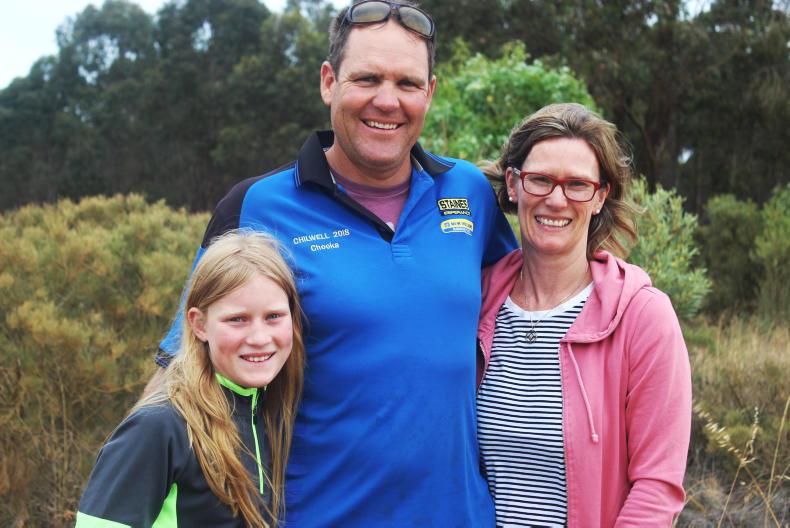
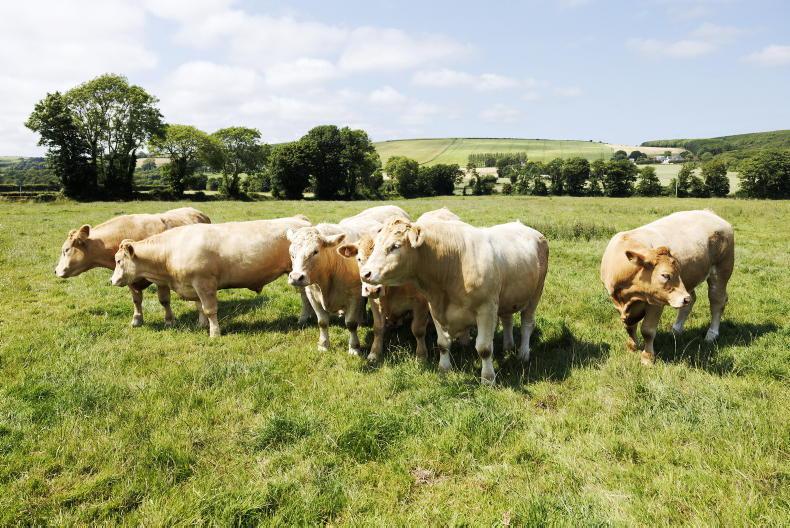

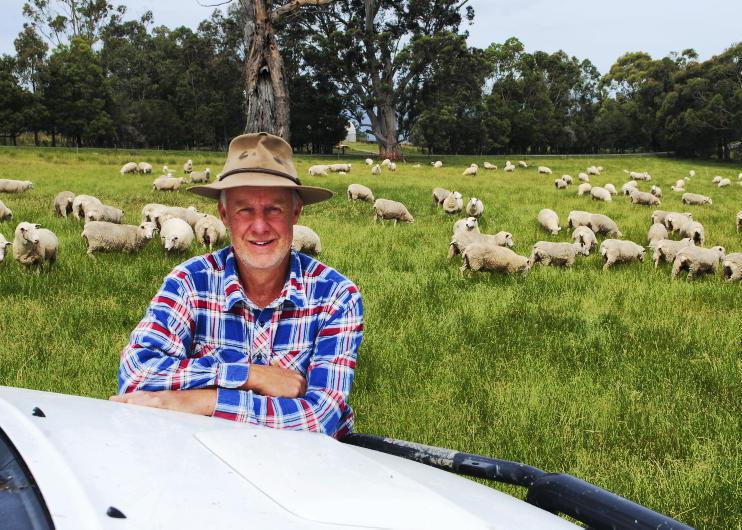
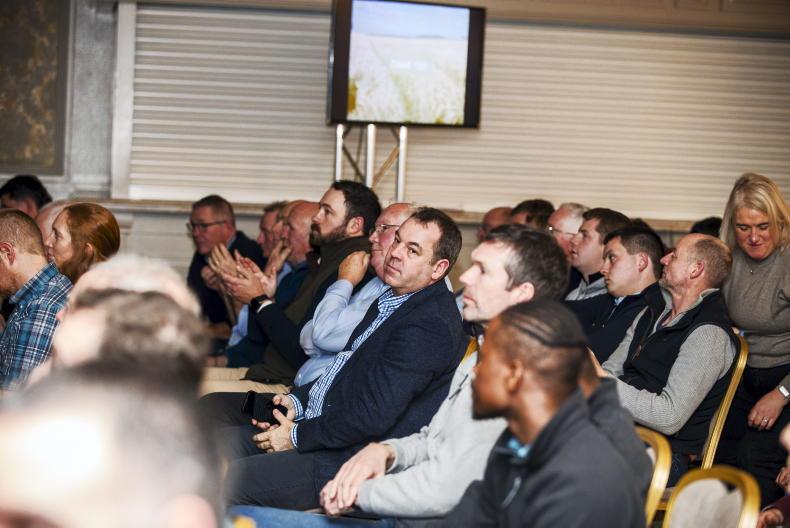
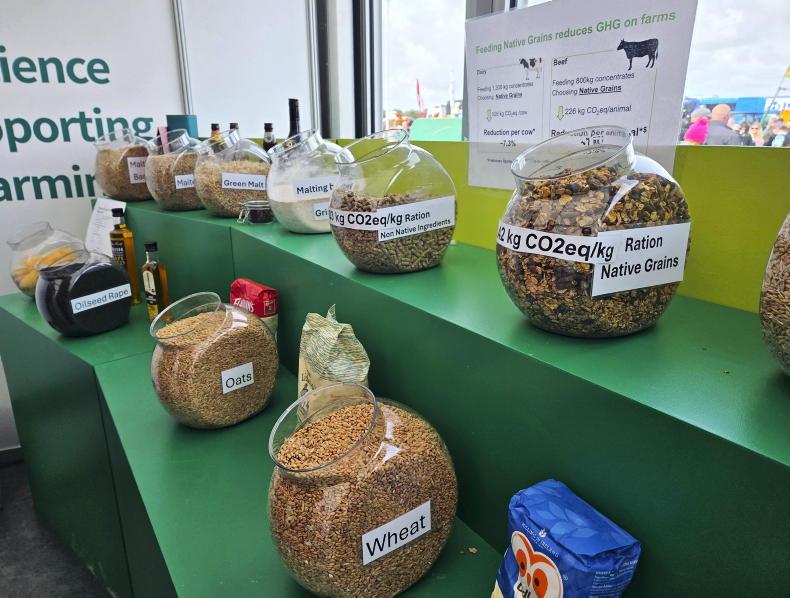
SHARING OPTIONS